SPORTS YOKOHAMA Vol.25:Feature04
![]()
[Courtesy of Yokohama City Fire Prevention Association]
Lifesavers who engage in surveillance and rescue activities at beaches and swimming pools are required to have first-aid skills as well. First aid refers to the emergency care of a victim of a sudden injury or illness that is provided by someone else present at the scene to prevent the injury or illness from worsening before professional medical care is available. Just imagine that someone you care about suddenly has a heart attack or stops breathing. He or she needs emergency medical care as soon as possible.
You are advised to take a class in first aid and gain the necessary knowledge and skills just in case.
 Check and see if the victim is responsive.
Check and see if the victim is responsive.
Speak loudly to the victim as you pat him or her on the shoulder gently.
If the victim is conscious, administer the proper first-aid treatment and call for an ambulance and, if necessary, an AED.
“Are you all right?”
![]() If not responsive
If not responsive
 Call for an ambulance.
Call for an ambulance.
Ask people nearby to dial the emergency number and to get an AED. A good way to do this is to ask particular people.
“You, please call an ambulance. And, you, go and get an AED, please.”
![]()
 Secure the airway.
Secure the airway.
If the victim is unconscious, the tongue may block the throat. Secure the airway to prevent the victim from choking.
![]()
 Check and see if the victim is breathing normally.
Check and see if the victim is breathing normally.
While securing the airway, watch how the victim’s chest moves, and hear and feel him or her breathe.
“Use all five senses.”
![]()
If breathing normally
 Recovery position
Recovery position
If the victim is unconscious but breathing normally, place him or her in the lateral recumbent position so as to prevent choking, with the face resting on the back of the hand and the knee of the upper leg bent at 90 degrees.
If not breathing
 Artificial respiration
Artificial respiration
Pinch the victim’s nostrils, place your mouth over the victim’s mouth and blow into the victim’s lungs for about one second while checking if the chest cavity rises. Then, repeat the process once again.
“Check if the chest cavity rises.”
![]()
![]()
 Breastbone compression
Breastbone compression
(cardiac compression)
Place your hands, one on top of the other, in the center of the chest of the victim (the middle of an imaginary line drawn between the nipples) and press down on the chest 4 to 5 cm at a rate of 100 times per minute; repeat this process 30 consecutive times.
If the victim is a child whose body size is smaller than that of an adult, press down not deeper than a third the thickness of the chest.
“Do not bend your elbows; put the weight of the upper part of your body on your straight arms.”
Cardiopulmonary resuscitation (performing breastbone compression 30 times and artificial respiration twice)
Repeat the cardiopulmonary resuscitation procedure until the ambulance crew arrives. When an AED is available, turn on its power, attach the pads to the victim and continue cardiopulmonary resuscitation as instructed by voice guidance.
AED (automated external defibrillator)
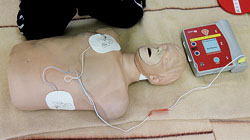 An AED is a portable medical device that automatically conducts arrhythmia analysis during ventricular fibrillation and applies electric shock (defibrillates) as necessary in order to restore the normal heart rhythm. Because the device is fully automated and offers voice guidance on the procedure, anyone can use it.
An AED is a portable medical device that automatically conducts arrhythmia analysis during ventricular fibrillation and applies electric shock (defibrillates) as necessary in order to restore the normal heart rhythm. Because the device is fully automated and offers voice guidance on the procedure, anyone can use it.
Lifesaving Workshops Are Held Frequently
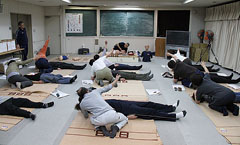
The half-day regular course (three hours long) offers lessons on how to perform cardiopulmonary resuscitation and how to use an automated external defibrillator (AED) for adult victims. The one-day regular course (eight hours long) covers cardiopulmonary resuscitation for infant and child victims and injury treatment in addition to the lessens given in the regular course.
[Location] Yokohama City Municipal Disaster Prevention Center (West Exit of the Yokohama Station), Yokohama City Fire Prevention Association (Kamiooka), etc.
* Workshops are held frequently. For details, including the schedule and the information about how to sign up for the workshop, call Yokohama City Fire Prevention Association at 045-714-9911 or visit the homepage of the association at the following URL:
http://www.yfp.or.jp/
![]()
[Courtesy of Yokohama City Fire Prevention Association]
Lifesavers who engage in surveillance and rescue activities at beaches and swimming pools are required to have first-aid skills as well. First aid refers to the emergency care of a victim of a sudden injury or illness that is provided by someone else present at the scene to prevent the injury or illness from worsening before professional medical care is available. Just imagine that someone you care about suddenly has a heart attack or stops breathing. He or she needs emergency medical care as soon as possible.
You are advised to take a class in first aid and gain the necessary knowledge and skills just in case.
 Check and see if the victim is responsive.
Check and see if the victim is responsive.
Speak loudly to the victim as you pat him or her on the shoulder gently.
If the victim is conscious, administer the proper first-aid treatment and call for an ambulance and, if necessary, an AED.
“Are you all right?”
![]() If not responsive
If not responsive
 Call for an ambulance.
Call for an ambulance.
Ask people nearby to dial the emergency number and to get an AED. A good way to do this is to ask particular people.
“You, please call an ambulance. And, you, go and get an AED, please.”
![]()
 Secure the airway.
Secure the airway.
If the victim is unconscious, the tongue may block the throat. Secure the airway to prevent the victim from choking.
![]()
 Check and see if the victim is breathing normally.
Check and see if the victim is breathing normally.
While securing the airway, watch how the victim’s chest moves, and hear and feel him or her breathe.
“Use all five senses.”
![]()
If breathing normally
 Recovery position
Recovery position
If the victim is unconscious but breathing normally, place him or her in the lateral recumbent position so as to prevent choking, with the face resting on the back of the hand and the knee of the upper leg bent at 90 degrees.
If not breathing
 Artificial respiration
Artificial respiration
Pinch the victim’s nostrils, place your mouth over the victim’s mouth and blow into the victim’s lungs for about one second while checking if the chest cavity rises. Then, repeat the process once again.
“Check if the chest cavity rises.”
![]()
![]()
 Breastbone compression
Breastbone compression
(cardiac compression)
Place your hands, one on top of the other, in the center of the chest of the victim (the middle of an imaginary line drawn between the nipples) and press down on the chest 4 to 5 cm at a rate of 100 times per minute; repeat this process 30 consecutive times.
If the victim is a child whose body size is smaller than that of an adult, press down not deeper than a third the thickness of the chest.
“Do not bend your elbows; put the weight of the upper part of your body on your straight arms.”
Cardiopulmonary resuscitation (performing breastbone compression 30 times and artificial respiration twice)
Repeat the cardiopulmonary resuscitation procedure until the ambulance crew arrives. When an AED is available, turn on its power, attach the pads to the victim and continue cardiopulmonary resuscitation as instructed by voice guidance.
AED (automated external defibrillator)
 An AED is a portable medical device that automatically conducts arrhythmia analysis during ventricular fibrillation and applies electric shock (defibrillates) as necessary in order to restore the normal heart rhythm. Because the device is fully automated and offers voice guidance on the procedure, anyone can use it.
An AED is a portable medical device that automatically conducts arrhythmia analysis during ventricular fibrillation and applies electric shock (defibrillates) as necessary in order to restore the normal heart rhythm. Because the device is fully automated and offers voice guidance on the procedure, anyone can use it.
Lifesaving Workshops Are Held Frequently

The half-day regular course (three hours long) offers lessons on how to perform cardiopulmonary resuscitation and how to use an automated external defibrillator (AED) for adult victims. The one-day regular course (eight hours long) covers cardiopulmonary resuscitation for infant and child victims and injury treatment in addition to the lessens given in the regular course.
[Location] Yokohama City Municipal Disaster Prevention Center (West Exit of the Yokohama Station), Yokohama City Fire Prevention Association (Kamiooka), etc.
* Workshops are held frequently. For details, including the schedule and the information about how to sign up for the workshop, call Yokohama City Fire Prevention Association at 045-714-9911 or visit the homepage of the association at the following URL:
http://www.yfp.or.jp/
 ハマスポ
ハマスポ
 お知らせ&トピックス
お知らせ&トピックス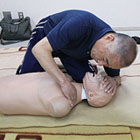 Check and see if the victim is responsive.
Check and see if the victim is responsive.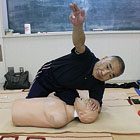 Call for an ambulance.
Call for an ambulance.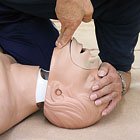 Secure the airway.
Secure the airway.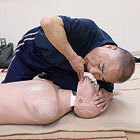 Check and see if the victim is breathing normally.
Check and see if the victim is breathing normally.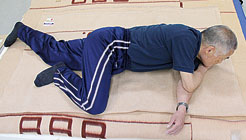 Recovery position
Recovery position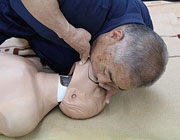 Artificial respiration
Artificial respiration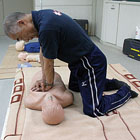 Breastbone compression
Breastbone compression ページトップへ戻る
ページトップへ戻る ページトップへ戻る
ページトップへ戻る

